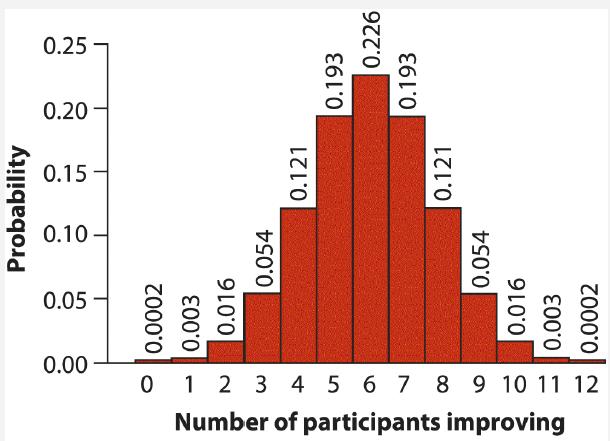Refer to Problem 28. The researchers also found that 11 of 12 participants showed improved accuracy in
Question:
Refer to Problem 28. The researchers also found that 11 of 12 participants showed improved accuracy in the exposed nostril after 21 days.
a. Carry out the four steps of hypothesis testing, to test whether accuracy scores changed after 21 days in the exposed nostrils of participants. Use
significance level α=0.05. ![]()
b. Why would it be useful also to provide a confidence interval for the proportion of participants improving?
Data from problem 28
About 30% of people cannot detect any odor when they sniff the steroid androstenone, but they can become sensitive to its smell if exposed to the chemical repeatedly. Does this change in sensitivity happen in the nose or in the brain? Mainland et al. (2002) exposed one nostril of each of 12 nondetector participants to androstenone for short periods every day for 21 days. The other nostril was plugged and had humidified air flow to prevent androstenone from entering. After the 21 days, the researchers found that 10 of 12 participants had improved androstenone-detection accuracy in the plugged nostril, whereas two had reduced accuracy. This suggested that increases in sensitivity to androstenone happen in the brain rather than the nostril, since the epithelia of the nostrils are not connected. The authors
conducted a statistical hypothesis test of whether accuracy in fact did change. Let ![]() refer to the proportion of non-detectors in the population whose accuracy scores improve after 21 days. Under the null hypothesis,
refer to the proportion of non-detectors in the population whose accuracy scores improve after 21 days. Under the null hypothesis, ![]() (as many participants should improve as deteriorate in their accuracy after 21 days). The alternative hypothesis is that
(as many participants should improve as deteriorate in their accuracy after 21 days). The alternative hypothesis is that ![]() (the proportion of participants increases or decreases after 21 days). The accompanying figure shows the null distribution for the number of participants out of 12 having an improved accuracy score. The probability
(the proportion of participants increases or decreases after 21 days). The accompanying figure shows the null distribution for the number of participants out of 12 having an improved accuracy score. The probability
of each outcome is given above the bars.

a. Did the authors carry out a one- or a two-sided test? What justification might they provide?
b. What is the test statistic for the test?
c. What is the P-value ![]() for the test?
for the test?
d. What is the appropriate conclusion? Use significance level α=0.05. ![]()
Step by Step Answer:

The Analysis Of Biological Data
ISBN: 9781319226237
3rd Edition
Authors: Michael C. Whitlock, Dolph Schluter





